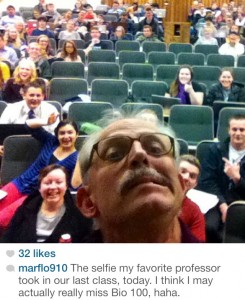
Sociologists refer to teenagers and young adults as the “like generation,” meaning young people now gain their self-esteem, build their self-image and feel popular based on how many likes their posts receive on social media.
Selfies have not only exploded on social media for teenagers but have also become a mechanism for companies and individuals of all ages to spread personal ideas and stories. Celebrities, politicians and advertising campaigns constantly post selfies on their social media accounts. From President Barack Obama to the Pope and even to BYU’s President Kevin J. Worthen, public figures engage with their audiences by posting selfies from all over the world.
In a study conducted at UCLA, psychology professors noted that humans are unconsciously wired to respond to faces. Selfies, therefore, fulfill a need to engage in human interaction, which people miss through text messaging. Because people prefer interactions that revolve around images, the Internet is crowded with photographs as people continue to produce more image-heavy content.
Instagram currently reports that an average of 60 million photos are posted every day on its site. Likewise, Snapchat claims it processes more than 350 million photos each day on its site. Instagram reports that posts with the most likes and the highest traffic include people’s faces as the subject and central focus.
Student opinions vary on the topic of selfies posted on Instagram. Some state that they are acceptable through a funny Snapchat, while self-centered and “annoying” when shared to the masses on Instagram.
Taylor Watts, a senior majoring in exercise and wellness, shared her thoughts on people taking selfies. “I think selfies are mostly about vanity; why else would you share them if you didn’t think you look awesome?”
Others think selfies tell a story, and that the main purpose in sharing them with others is to publicly journal people’s daily activities and memories.
Chase Hudson, a marketing major, shares selfies through Instagram and Snapchat regularly to express emotion and experiences with his friends. He stated, “Everything is visual now. I like to send quick videos of concerts, weird things happening on campus or just funny moments with my friends to people that I am close with. It makes me feel connected and close to them.”
The ability to share these moments with everyone they know enables people to communicate easily and feel empowered by being heard or seen by large groups of people through social media. However, Patrick Steffen, an assistant professor of BYU’s Department of Psychology, stated that social media is dangerous when it is perceived as reality.
People primarily only post their moments of extreme happiness, success and triumph. People don’t see a lot of pictures of failed tests or lunches eaten in the cafeteria alone. People imagine what their ideal life would be, try to create it and then claim it as their own through social media.
Even when people go to an event, it is not always publicized and recorded just as it was. The high points are shared. If there was a moment of dullness or a poor turnout, all can be swept away by a photo of everyone huddled together smiling like they are having the time of their lives.
Elder Quentin L. Cook, a member of the LDS Church’s Quorum of the Twelve, quoted Arthur C. Brooks in his address during the October priesthood session of general conference, reciting, “How could it not make you feel worse to spend part of your time pretending to be happier than you are, seeing how much happier others seem to be than you?”
Selfies enable people to take photographs of themselves to be seen, not as they are, but as they want to be.
Tyler Evenson, a junior majoring in advertising, expanded on this thought. “Selfies change the way we view each other and interact because some people are loud and talk a lot on social media, but they are shy and quiet in person. Getting to know people through social apps like Tinder or Instagram is risky because people don’t always look or act as they do through the lenses of their iPhones.”
In his talk “Are You Sleeping through the Restoration?” President Dieter F. Uchtdorf, of the LDS Church’s First Presidency, discussed people’s self-consumed habits, stating, “Past generations had their struggle with variations of egotism and narcissism, but I think today we are giving them serious competition. Is it any coincidence that the Oxford Dictionary recently proclaimed ‘selfie’ as the word of the year?”




